The US
Lagos-Besteiro Family:
A History-2
1912 to 1921: The New York Years (&
a return to Havana)
By Emilito
Rev. 2005-02-08
home
| Family
Stories, Pictures, etc
| Family
Trees
| Rugby Stories, Data,
Pictures, etc
| Miscellaneous
Under construction
1912: the start
of the New York years.
When Antonio Lagos got off the boat from Havana on 13 February 1912 he
listed his destination as "Hotel American, NY City." Where that was,
Emilito does not know, and in fact he has seen so many people headed
for "Hotel American NY City" on Ellis Island manifests that he suspects
it is a synonym for "I don't know." He does, however, know
whither Pepita and her 3
children said they were heading on their September 18 arrival: 290 West
12th Street. Located in the part of Greenwich Village known as
the "West Village," it is near the corner of West
4th Street (Emilito found to his surprise that not all NY numbered
streets are
parallel (although winding West 4th Street is the only numbered "Street" to
intersect with other numbered "Streets" in Manhattan).
The current (2005) location of 290 West 12th Street is shown on
the photograph below. The building now there was constructed in 1965;
only the tall building at the far corner is the same as in 1912
(Emilito found
information which was very helpful in studying old family addresses at http://www.nycpropertyresearch.com/mason/).
Incidentally, Emilito found, in that tall building which is 302 West
12th Street, condominiums selling in 2005 for more than a million
dollars.
 The 3rd
house from the corner is the current 290-294 W.
12th St.
(1/1/2005)
The 3rd
house from the corner is the current 290-294 W.
12th St.
(1/1/2005)
Photo taken facing west from the intersection of W. 12th St. and W. 4th
St.
The tall 17-story) building, 302 W. 12th, is the only building that
predates 1912.
Emilito adds a quick caveat: although the address as given on the Ellis
Island Manifest was 12th Street, Carmen wrote that "Our first
home, I heard, was on 14th Street near Jane and Union Square.." While the 12th
Street house is only a stone's throw from Jane, it is a few blocks from
Union Square. Emilito
suspects that the 12th Street address is correct, but as will be made
clear later, the Ellis Island manifests are far from perfect.
1913-14:
guess what?
If your answer was, "More babies," you'd be right. When Dolores
Lagos was born in New York on 31 July 1913, Emilito's Maina had given
birth to 4 babies within a 33-month period. Perhaps she cried for
a brief respite, because Antonio was not born until 31 October 1914, a
whopping 15 months and 18 days later.
By the time of baby Antonio's birth the family
had moved uptown to 239 E. 79th Street, near the corner of 2nd
Avenue.
We know this because on the 12th of November 1914 Papa's brother
Manuel,
his wife Victorina (Maina's mother, for those that have been following
Emilito's saga), and Victorina's youngest child, Isabel BESTEIRO
GRACCIANI (yes, she was GRACCIANI whereas Pepita was GRACIANI; Emilito
notes that this spelling issue will be a subject of a future treatise),
landed at
Ellis Island. They gave their destination as "239 E. 79th Street
for 15 days Bro. Antonio." The family had moved to the Upper East
Side.
 Antonio Lagos (Papa)
with
children Carmen and Manuel at 239 E. 79th Street
Antonio Lagos (Papa)
with
children Carmen and Manuel at 239 E. 79th Street
Probably taken in the Fall
of 1914
 239 E. 79th St. on 1/1/2005
(far right house, corner of 2nd Avenue)
239 E. 79th St. on 1/1/2005
(far right house, corner of 2nd Avenue)
View to the NW is
from the SE corner of 2nd Avenue
This building, now
legally "1523-1535 2nd Avenue," was built in 1957.
The former corner lot was 245, and the 4-story building to the left is
237,
so old 239 would have occupied the left corner of the current corner
building
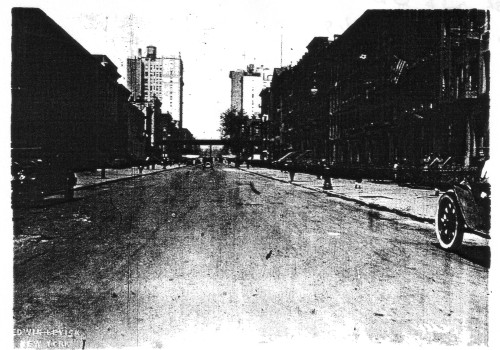
This is the view, from roughly the same spot, in May 1919.
This is likely very simlilar to that in 1914
Note the 3rd Ave "El" (elevated train), now gone, in the background.
239 would on the right nearest the camera, but poasibly cut off.
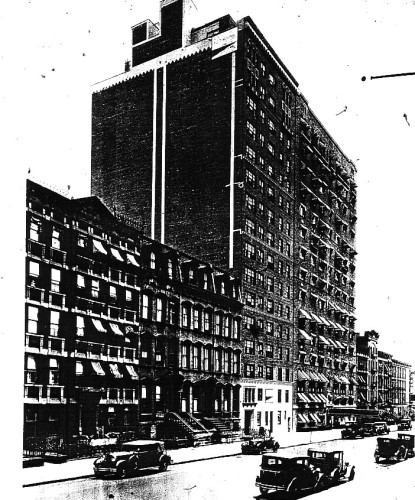
This is 221 to 245 E 79th from the SW. The far building is the
corner of 2nd Ave.
Photo taken in 1930, the year the tall buildings in the middle were
built.
The 5 story
bldg (4th from far corner & sticking up one story) is probably the
239
where Lagoses lived.
The three passengers were listed as "Manuel Lagos," "Victorina
Graciana," and "Isabel B.
Graciana." Therefore a
search for
either "Victorina Graciani," or "Isabel Besteiro," or even "Victorina
Lagos" or "Victorina De Lagos" would have come up empty. Only through
the good fortune (from Emilito the researcher's point of view, anyway)
of
traveling with Manuel Lagos were they
able to be spotted on
this trip's manifest.
 1914 Ellis Island
Manifest Showing Misspelling (and age "error")
1914 Ellis Island
Manifest Showing Misspelling (and age "error")
Also, one of the items the Ellis Island database
(www.ellisislandrecords.org)
asks you to enter when searching for ancestors
is "approximate year of birth." Well, Victorina put down her age as
42. Subtracting her birth date (23 March 1862) from the arrival
date, we get 52. An inadvertent mistake? Read on.
Victorina Graciani: liar! liar! pants
on fire! Victorina is in
the Ellis Island database at least five times. Besides the fact
that she is not listed twice under the same name, her declaration of
age is no less inconsistent.
Listed as
Arrival Date accompanied
by listed age Actual age Difference
Victorina Graciana 1914-11-12
Manuel, Isabel
42
52
10
Victorina G Lagos 1915-08-18
no one
45
53
8
Victorina Lagos
1920-04-20 3 Besteiros
45
58
13
Victorina Graciani
1922-11-21 no one, "single"
48
60
12
Victorina De Lagos 1924-04-07
Manuel
52
62
10
So, briefly ignoring the name issue, if you knew her year of birth was
1862 and
you used this search field and put in the biggest range allowed in the
search,
+/- 7 years, you would have missed all these arrivals.
Oddly, on the 1922 trip she was listed as "single." This
seems to be an interesting - if confusing - era for Manuel and
Victorina, but as it happened after the New York years it will not be
dealt with here. What stories one can imagine, ponders Emilito,
if one just reads between the lines.
Perhaps of interest as well, but no longer surprising, given the lack
of consistency in Ellis Island records, is that in the 1924 trip
Victorina De
Lagos was indexed under "L," whereas her daughter on her 1917 trip
from Havana (discussed below) was listed as Josefa Delagos, indexed
under "D."
1914-17:
Tragedies, radical solutions, war. 1914 ended, and 1915
started, with double family tragedies. On 30 December, baby
Antonio
died, a
day short of 2 months old. Less than 3 weeks later, Lolita,
nearly a year and a half old, died as well.
Their sister Carmen,
Emilito's mother, noted that Antonio died of an infection in his navel
which was probably caused by a coin the midwife put over it to flatten
it. Lolita died of whooping cough.
Not leaving well enough alone, Emilito went to NY in early 2005 and was
able to track down their death certificates
and get a copy at the NY
Municipal Archives at 31 Chambers Street. On the death
certificate
for Dolores, "cause of death" was listed as "Cardiac Incompetency and
Broncho-pneumonia." Another field, "Contributory," said
"Gastro-enteritis."
And Antonio? His death certificate said the cause of death was
"Gastro-enteritis." Contributory? "Malnutrition of mother."
Emilito has no idea if these differing sets of words can be
reconciled. He does admit to initially being astonished at the
"malnutrition
of mother" phrase. Then he remembered the story of Uncle Manny's
failing health on board ship from Spain to Cuba, and how a wet-nurse
found on board was needed to nurse him back to health.
Another reason Emilito wanted to see the death certificates is that he
thought to himself, "Gee, they're probably buried somewhere." And, in
fact, both children were listed as being buried in Calvary
Cemetery. Emilito looked very hard to find a Calvary Cemetery in
Manhattan but his searches for this cemetery were continually cluttered
by references to a Calvary Cemetery in Woodside, Queens. "They
would never have had them buried in Queens," thought Emilito.
That is, until he found a Newsday article online entitled "The Cemetery
Belt: Why does Queens have so many cemeteries? Answers go back to
mid-1800s Manhattan." It turns out that as early as
the 1830s, Manhattan church graveyards were no longer sufficient to
bury the dead, and "the churches looked to rural Queens." In 1852
the Common Council of New York City (then consisting only of Manhattan)
passed a law prohibiting any more burials." Click here
to see the article.
Another interesting item on the death certificate - under "character of
premises," it states "tenement." Emilito always
thought that tenements were apartments where only hopelessly poor
people lived. This family, however, from all accounts was not
hopelessly poor. Poor enough, he guesses. Even on the
world-wide-web it is not easy to find some clear distinction between
tenement apartments and non-tenement apartments.
So - was there any way of finding out exactly where Antonio and Dolores
were
buried? Are their graves marked? Emilito sent a letter to
Calvary Cemetery and got a quite surprising response: click here to see it.
At any rate, back to the deaths of the children: "Fortunately," wrote
Carmen, "Aunt Betty (Isabel BESTEIRO GRACCIANI) was staying with us at
the time, which made it possible for Maina to stay with us children
while she accompanied Papa to each of the funerals."
Speaking of "Aunt Betty," Emilito would like to grumble about just how
much the family overcompensated in trying to assimilate to its new
country. Maina's sister Isabel
was introduced to us kids, norteamericanos all, as "Aunt Betty,"
and her brother Domingo was "Uncle
Dominic." Tío Domingo's son Ricardo Besteiro was
""Richard." Etcetera. And Emilito's father himself, when he
became a US
citizen, changed his name from "Emilio SIGNES MONFORT" to "Emil Monfort
SIGNES." After some agonizing, his parents listed Emilito as
"Emil George" on his birth certificate. In retrospect, Emilito
thinks these were all unfortunate
choices.
When Victorina visited in August 1915, she listed as her destination
the Lagos family at 344 E. 85th Street, a few blocks uptown in a
neighborhood called
Yorkville.
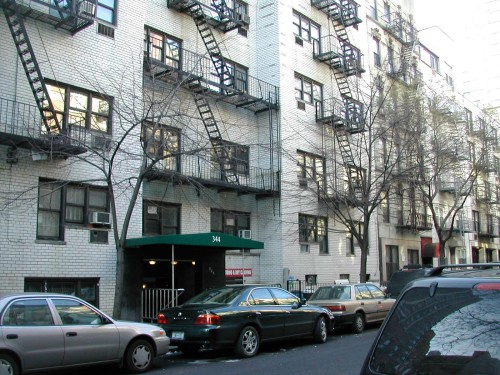 Facing west. The
house with the
awning is the current 344-348 East 85th Street (1/1/2005)
Facing west. The
house with the
awning is the current 344-348 East 85th Street (1/1/2005)
The house pictured here was built in 1920, 5 years after the family
lived at this address.
We have no known photos of either Antonio or the first Lolita. In
Antonio's case, it's
understandable, as he died at 2 months. But for Lolita to have
lived for a year and half without a photo being taken is surprising.
1915 is a blank. Besides Victorina's August visit, we have no
photos of anyone, no historical
tidbits, nothing.
Maina was convinced that New York was cursed, and refused to have any
more children there. So, when (inevitably, as we must know by
now)
she became pregnant again in early 1916, she insisted on having her
baby born in Havana. Sometime in late 1916 (we don't know
exactly when, because we have no departure records and Emilito is not
yet psychologically prepared for repeat days-long examinations of Diario de la Marina) she packed up
Carmen, Manny and Vicky and headed to Havana.
The photos below, taken in late 1916, were shared among the separated
family members. The caption of the first is "Antonio Lagos Toledo
solito en Nueva York" (Antonio alone in
New York). The next two are of Carmen and Vicky in Havana (aged 6 and
4, respectively).
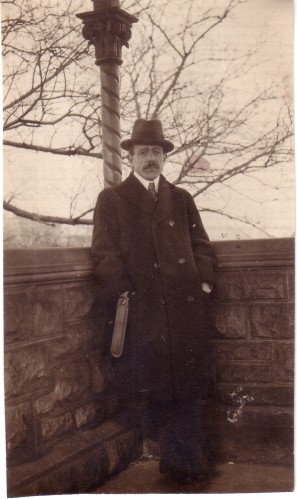 Antonio Lagos alone in
NY: late 1916
Antonio Lagos alone in
NY: late 1916
 The two Lagos sisters
- L to R Carmen and Vicky - in Havana, December 1916
The two Lagos sisters
- L to R Carmen and Vicky - in Havana, December 1916
The 2nd Dolores
(the one all of us knew and loved) was born in Havana on New Year's Day
1917. The name on her birth certificate? María
de los Dolores Emilia Manuela Lagos y Besteiro.
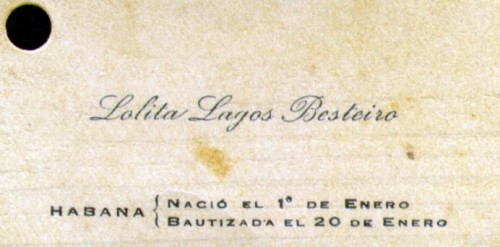 Announcement
of Dolores Lagos birth and baptism
Announcement
of Dolores Lagos birth and baptism
Emilito remembers, when he was very young, his Aunt
Dee Dee (Dolores AKA Lolita) would tell him that she was celebrating
her 21st
birthday each and every New Year's
Day . Being quite good at math even at an early age, he was
quite impressed by this annual feat, equating it on the miracle scale
perhaps
with a virgin birth
(whatever that might be).
The address in Havana where Lolita was born was given as San
Lázaro 198, an oft-referenced family address in Havana.
When Emilito was there in 1999, however, there was no 198: either it
was torn down or - what Emilito thinks is more likely - the house
numbers in Havana changed sometime during the
20th century.
Pepita and kids were certainly in no hurry to leave Cuba as March 1917
found them still lollygagging around Havana. Late that month,
however, they received a letter (or possibly a telegram) from Antonio
in New York advising them to return home immediately. According
to his information, the US was about to declare war on Germany, which
would likely make it impossible for them to return during its
duration.
When she and her
children (Carmen, Manuel, Victorina and the baby Dolores) prepared to
depart from Havana, it was discovered that Manuel had pink eye and he
was forbidden to leave. Afraid to delay their trip
because of her husband's
admonition, she boarded the boat with the other kids and left Manuel in
the care of his
grandmother and tía Isabel (Aunt Betty) for
approximately 2 years. The boat, the S.S. Mexico, left Havana at
29
March 1917 and arrived in New York on 2 April. The US declared
war on
Germany on 6 April.
April
1917: return to NY. When they arrived, they headed to 12
E. 46th Street - the Lagoses were
now in Midtown.
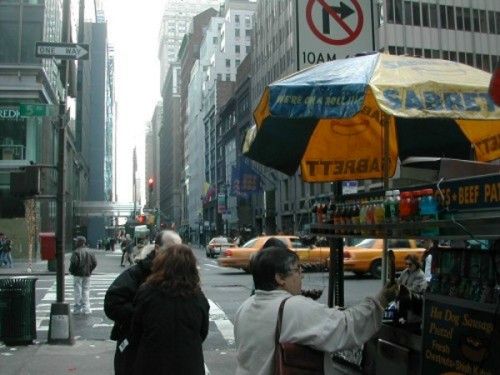 12 E. 46th Street is
across 5th Ave, on the right, 4th building from corner
12 E. 46th Street is
across 5th Ave, on the right, 4th building from corner
Photo taken
1/1/2005. Heide Ruppel (Signes) is buying a pretzel.
Or were
they?
Or were they?
Emilito has always suspected this address, although it is clearly the
one given in the Ellis Island Manifest. It didn't make sense
(although it was possible) for them to briefly move from the Upper East
Side to Midtown and then back. More importantly, Emilito's mother
never mentioned this address. Finally, this is not a residential
neighborhood, and Emilito was pretty sure that it wasn't back then
either.
Emilito had a bright idea! A work address! Early in 2005,
remembering that his Papa had worked for the Cortina Academy of
Languages while in New York, Emilito took to Google. Somehow (and
he
has not found his way there since!) he found a list of City Directories
of the United States. There it was - from R. L.
Polk & Co's Trow General & Business Directory of the Boroughs
of Manhattan & Bronx City of New York, New York for 1917 - Cortina
R D Academy of Languages (R D Cortina Co) 12 E 46th!
Emilito considers this one of those rare strokes of genius that
sometimes surprise him.
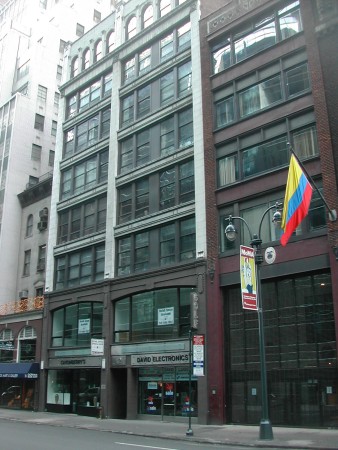 12 East
46th Street (David Electronics sign) in 2005
Built in
1915, this building is where Cortina was located in 1917
12 East
46th Street (David Electronics sign) in 2005
Built in
1915, this building is where Cortina was located in 1917
So - one hopes they didn't sleep on the floor of Papa's office.
Emilito can imagine a couple of scenarios; he favors the
following. 344 East 85th Street was too small for 4
children. Poor
procrastinating Papa promised Pepita larger Lagos living quarters, but
with the sooner-than-anticipated US involvement in World War I,
couldn't deliver in time. He therefore instructed them to put the
Cortina address on the manifest. By
the time they arrived he promised he would have a place to stay.
This
may be the place to discuss the question of Antonio's employment
in New
York. Emilito does not have an entire 1912-1921 employment
history, but it appears that for most of those years Antonio was
employed by the Cortina Academy of Languages. The
Cortina Academy of Languages was founded in 1882 by Professor Rafael
Díaz de la Cortina and originated the recorded method of
language learning, using early cylinders developed for Cortina by
Thomas Edison. The company continues today as Cortina Learning
International, located
in Wilton, CT (www.cortinalearning.com).
Antonio's daughter Carmen wrote that Antonio was "chief instructor and
manager" at the Cortina Academy of Languages. "Papa taught at Cortina,"
wrote Carmen, " . . . and sold their language records at seminars of
big business Boards of Directors, which were trying to encourage their
managers to learn foreign languages so as to broaden their business
base
abroad." As well, it appears, as teaching foreigners coming to the
US. Emilito also
notes that in his inherited record
collection he has several 12" diameter 78 rpm Cortina instructional
records.
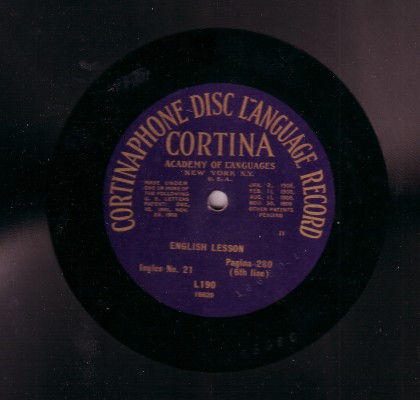 An English Lesson on a
12" 78-rpm Cortina record
An English Lesson on a
12" 78-rpm Cortina record
Speaking of old 12" 78 rpm records, Emilito also inherited a bunch of
music on this medium, among which are found several early Pablo Casals
performances. He reckons that these, too, were part of Antonio's
acquisitions during the New York era.
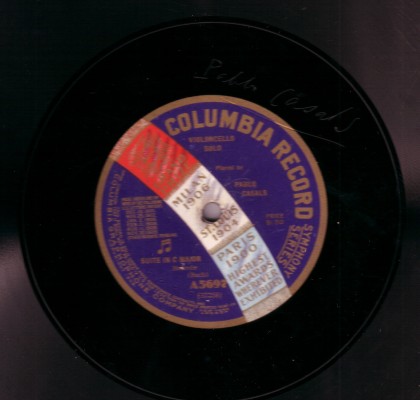 Early Pablo Casals
performance on 12" 78 rpm record.
Early Pablo Casals
performance on 12" 78 rpm record.
Note Casals'
"signature" impressed into the label margin.
So anyway, where was the
new family household? The next address on record is that which
tía Joaquina (see below) listed on the Ellis Island manifest on
her August visit, 526 East 83rd Street, another house in the Yorkville
neighborhood. As no other address was mentioned, Emilito reckons
that this was the family's most likely destination. If true, it
would mean they lived there for more than 4 years, nearly half the
family's stay in New York.
Carmen
Lagos wrote that "our last home in that city
was at 526
East 83rd Street. This
was
near the East
River
where there was a park where we went
roller skating.
. . Uncle Mannie said the house had been torn down to build a
highway."
From Emilito's perspective, this would have been a sad fate. But Uncle
Manny had been wrong. The house is still there,
between East End and York Avenues; the highway - the FDR Drive - is
more than a
block away. The park in
question may well be the Carl Schurz Park on E. 86th Street adjacent to
the East River, which was
dedicated in 1902.
Not only is there a building there, it is the same building in which
the family lived, as it was built in 1900. Emilito could not find
a picture of the building from those years, but right now it is a
beautiful house in a very beautiful neighborhood (see below). It
is also the very first place that the entire family - Maina and Papa
and their six surviving kids - ever lived together.
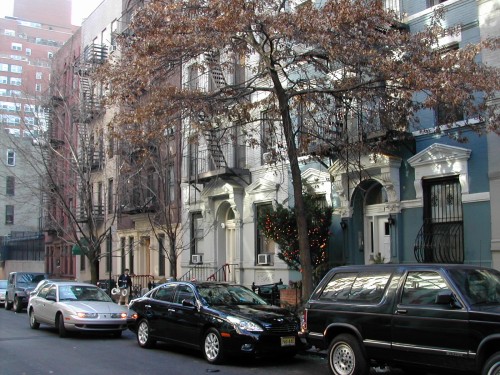 Last NY address - 526
E. 83rd (blue house on right) - between East End and York Aves
Last NY address - 526
E. 83rd (blue house on right) - between East End and York Aves
Photo taken 1/1/2005. The East River is one block to the left.
This house was built in 1900, so is the one in which the family lived.
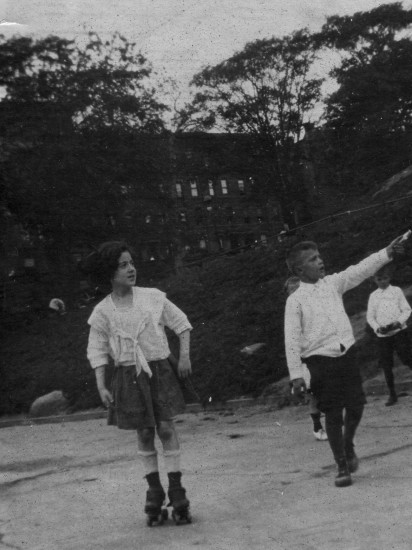
The caption on this picture reads
"Carmen skating in New York on East End Avenue and 86th Street."
Surely this Carl Schurz Park, and the year is approximately 1920
For a map of the
family addresses in Manhattan, click here.
1917-18:
Tía Joaquina visits.
The "US Lagos family" is but one branch of three families that moved to
Cuba in the early 1900s. Not all of its connections are Lagos or
Besteiro descendants. One of these is tía Joaquina
Lorenzo. Emilito will deal with these "outliers" on the tree in a
chapter on his Cuban family. At any rate, Maina's Aragonese
grandmother,
Joaquina LORENZO BLAS, had a brother Baltasar, whose daughter Joaquina
LORENZO GÓMEZ joined the family in Cuba at some as-yet
undetermined time in early the early 1900s (her presence at Maina
and Papa's wedding in Havana was a topic in the previous
chapter). Joaquina joined her relatives
in the US for about a year in 1917-1918 during which time she was "in
charge of" Dolores. Besides the wedding story, there are a couple
more tía Joaquina
stories that have survived to this day.
One is that, after Charlie's birth in 1918, she was reputed to say
(according to the story as smilingly propagated by Dolores),
"¿Por
qué has tenido que dar luz a éste? Le está
molestando a mi pequeñita." (Why did you bring him into
the world? He's annoying my little one.)
Also, there was a time while she was in New York that there was a bread
shortage, but as she walked down the street one day, she smelled bread,
and sighed longingly, "Hmm . . . bread." A man who had been
"secretly" making bread found this amusing, and gave her a loaf.
Antonio Lagos was amazed that she, who couldn't speak English, could
procure bread, while he had had no luck in his efforts to do so.
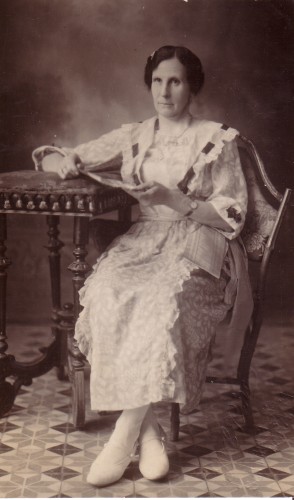 Joaquina Lorenzo
Gómez, Victorina's 1st cousin, Dolores' "guardian"
Joaquina Lorenzo
Gómez, Victorina's 1st cousin, Dolores' "guardian"
Picture was in
Carmen Lagos's 1910 decade book
1918:
The family continues to grow. As noted, Pepita
arrived in New York on 2 April 1917. An Emilito pop quiz: when do you
think her next child was born? I'm sure you're not far off: Uncle
Charlie was born on 16 January 1918, just 9 months 14 days after her
arrival. Yes, I know: it's not really a surprise, is it?
Carlos Antonio Lagos (although Emilito was not able to get his actual
birth certificate, he found him in the index to Manhattan births, where
he is listed as "Carlos A
J.," at the New York Public Library). A.J., huh? We're missing
his second
middle name. Carlos was born in New
York, and as he lived to the age of 80 finally broke the Lagos NY curse
(a NY curse broken in the same year, Emilito is curious to note, that
the Red Sox NY
curse was
born . . . )
Given her disenchantment with NY, why didn't Pepita go back to Cuba to
have Charlie? Emilito does
not remember ever discussing this with her daughters, but it is
certainly possible that one reason was the fact that World War I was
still raging with the US was now a full participant. And also, geez,
she had just gotten home!
After the death of their two children,
Antonio and Pepita named their next daughter Dolores (AKA Lolita) just
as they'd named their earlier daughter (sometimes referred
to within the family as "the first Lolita"). When it came to their next
son, however, he
was not named Antonio, but Carlos - a name that can be found nowhere
within either Lagos or Besteiro lines. Emilito asked his aunts
Dee and Jo "Why?" The answer he received was that they were told that
Charlie was named
after one of
Antonio's co-employees at Cortina.
1919: Manuel
returns? There was no
child activity in 1919, which in fact from a documentation point of
view is a very quiet year.
Although not documented, it is the general consensus that late 1919 or
early 1920 marked the return of Manolo to the US. While in Havana we know
that he attended the "Colegio Besteiro," a
school run by his tío Domingo.
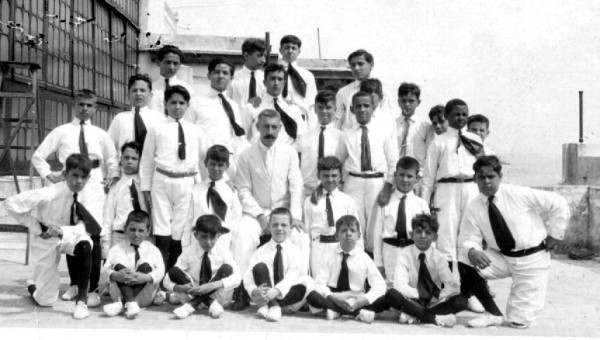 At Colegio Besteiro,
1918. Manuel Lagos is front center, right in front of his
tío Domingo
At Colegio Besteiro,
1918. Manuel Lagos is front center, right in front of his
tío Domingo
While in Cuba, Manolo also made good friends with Oscarito
González, a relative of Mario García, Aunt Betty's
fiancé. Oscarito would later
(1924, at age 14) come to Paterson to spend some time with the family
and at school where apparently he charmed the girls. When last heard
from (in the 1970s, although we know he is now dead), Oscarito was
living in difficult circumstances in
the US. He had escaped Cuba on the same plane as Fulgencio
Batista and
was later sentenced to death in absentia by the government of Fidel
Castro.
Family history has it that Uncle Manny's tío Manuel brought him
back, but they apparently didn't go through Ellis Island and Emilito
has found no documentation for the return.
1920: The first census and the last
child. The first census to list the Lagos family (all but
Josephine, who was
born on 13 January 1920, 4 days after the enumerator arrived) found
them still living at 526 E. 83rd Street.
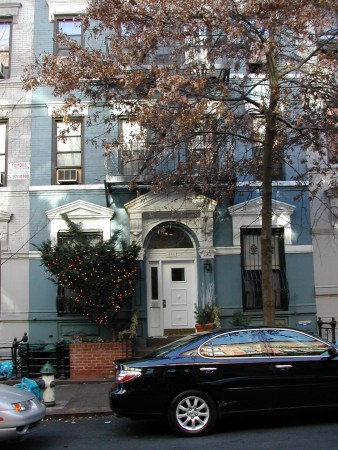 Facade of 526
East 83rd Street on 1/1/2005
Facade of 526
East 83rd Street on 1/1/2005
Emilito has yet to see his
Aunt Jo Jo's birth certificate, but she has told him that it is
virtually useless, as her name as spelled looked like "Bogos." In fact,
a search of the Manhattan birth index at the New York Public Library
uncovered no Lagoses, but there was an index entry to a
"Josephine T. Bogose" born on January 13. Emilito
has been spoiled by Spanish and Cuban documentation, which is orders of
magnitude better than that he has found in the US.
Also documented in 1920 was the first "mass visit" of Cuban family
members to visit the US relatives, visits (both ways) that would
continue unabated until the 2nd year of the Castro era. Emilito
will dedicate an
entire chapter of this web site to "the Cuban cousins."
At any rate, the visitors arrived on 24 April 1920 (Emilito's daughter
Heide's "minus 50th" birthday). They were headed by Victorina and
bound for 526 East 83rd Street. Curiously, Victorina listed that she
was going to visit her husband there, so it is possible that when
tío Manuel brought Manolo home, as noted above, he just stayed
in New York. This might argue for a 1920 Manolo return date, but
one never knows. Emilito will pursue this mystery (there are no
Ellis Island records).
Other members of the traveling party were Mercedes LORET DE MOLA
BETANCOURT,
tío Domingo's wife, and her children Ricardo (age 3) and Miguel
Ángel (age 1) BESTEIRO LORET DE MOLA,. They listed their length
of stay as 5 months.
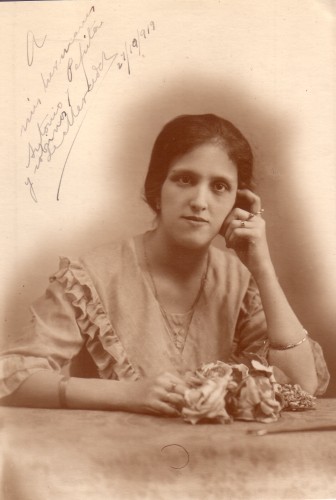 Mercedes Loret de Mola
in 1919, the year prior to visiting NY
Mercedes Loret de Mola
in 1919, the year prior to visiting NY
1921:
Goodbye, New York. Sometime during the year 1921 the
family packed up and headed to Paterson. The circumstances of how
they ended up there are unclear, but as in many cases, Emilito's mother
had written the "official family" story which goes something like this,
as
transcribed by Emilito's cousin Chipilina in the 1992 family reunion
book.
"A colleague of Papa's at Cortina applied for teaching positions in
Paterson High School and at the University of Indiana at the same
time. He was accepted at both of them. Very embarrassed, he
said to Papa, "I told both of them that I would be available for the
coming term, and now I have to let one of them down. Antonio, the
honor of Spain is at stake! Won't you take one of them?
"Because of the fragmented hours at the Cortina Academy, they had no
problems finding teachers, so that they would not be hurting the
school. Papa knew he couldn't even think of moving to Indiana
with six children, but said he would consider the Paterson offer.
After an interview and a review of credentials, he was accepted and for
several years he commuted by train."
Another
story from the Lagos family oral collection. Take it for whatever it
may
be worth.
Emilito can shed a little documented light on the chronology at
least. He has a letter to Antonio Lagos from the Paterson
Superintendent of Public Instruction, John Wilson, that indicates
Antonio was appointed on a substitute basis on September 1, 1919 and as
a regular teacher on February 1, 1921. Antonio would have had only five
children at the time he made this commitment, but Emilito
supposes he knew a sixth was "on deck."
This chapter, vivíparo
as it is, continues to grow out of Emilito's control, but he would like
to briefly mention one more piece of information. Emilito has in
his
possession another letter, this one a "To Whom It May Concern" letter
from A. Edward Wupperman of Cortina, a glowing recommendation for
Antonio. Emilito's mother comments at the bottom of this letter
"My note of an interesting fact: Mr. Wupperman was a brother of a then
famous actor, a very urbane gentleman who, I think, went by the name of
Frank Morgan." Well he may have been famous then, but he remained
famous and is still famous now: Francis Philip Wupperman, alias Frank
Morgan, was the
Wizard in The Wizard of Oz.
But enough of other people's family connections. We have plenty of our
own to explore.
As Emilito believes the family moved to Paterson somewhere around
mid-1921, this would mean Antonio commuted from NY to Paterson for
about two years. Whether he continued to work part-time for
Cortina, we don't know. Most likely not, as his 1921 MA from
Columbia suggests he must also have been studying part-time in that
time.
Antonio's MA picture follows, and Emilito has a copy of the Columbia
diploma, awarded on 23 February 1921. Emilito, by the way, has
absolutely no idea where (if) Antonio got his
bachelor's degree. But why sweat the small stuff?
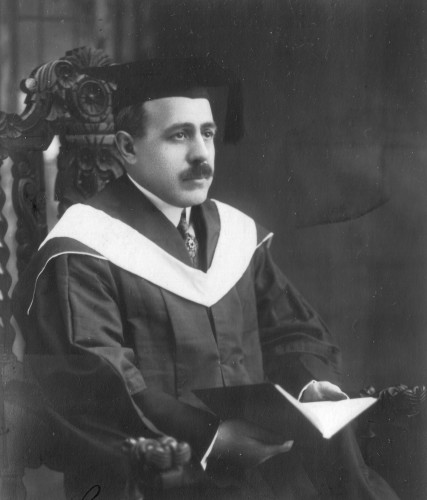 Antonio Lagos in cap
and gown as a Columbia MA recipient
Antonio Lagos in cap
and gown as a Columbia MA recipient
It is still unclear as to exactly when they left New York, but a
picture taken of Dolores on April 13 indicates that it almost
certainly was after that.
The
older Lagos kids remembered the trip well. Carmen writes that
"the
moving presented a problem. [Papa] hired the Lombardo movers,
relatives of a former student. Upon seeing what was to be taken,
the
mover came up with the idea of setting up the living room furniture in
the truck and having the family sit in it. Thus the
Lagos-Besteiro
family made its entrance into Paterson comfortably seated on their own
sofa and chairs, seeing everything through the iron fence-like back of
the truck." Furthermore, Emilito notes that as the Holland
Tunnel, the first Hudson
River
road crossing, was not built until 1927, the family
would have had to cross the river by ferry. Emilito thinks it
sounds like a hoot.
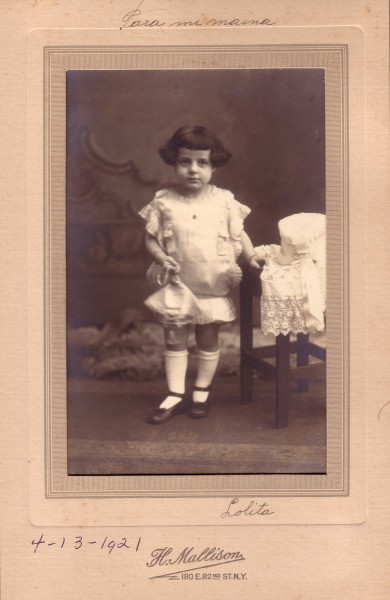 Lolita in
NY, 13 April 1921
Lolita in
NY, 13 April 1921
Caption: "Para mi maina" (to my Maina, i.e. Victorina Graciani)
Is this the last picture taken while the Lagos family were still New
Yorkers?
The New York era ended as
the Lombardo truck rumbled towards the Lagos family's first house in
Paterson (321 Market
Street). From that time, for more than 40 years - well into the
1960s -, the entire Lagos nuclear and extended family lived in or
within 5 miles of
Paterson. The saga continues, just 20 miles away from 526 E.
83rd, in part 3 of
Emilito's US Lagos series. The
Paterson era
begins.
US Lagos History 1 - 1909-1912: Cuba
and Spain
US
Lagos History 2 - 1912-1921: The New York Years
US Lagos History 3 - 1921-1934:
Paterson - the single years
US Lagos History 4 - 1934-1947:
Paterson - the Lagos kids get married
US Lagos History 5 - 1937-1961:
Paterson - grandchildren
US Lagos History 6 - The Lagos
Diaspora
<------ Am looking for any pictures
of Carlos and/or
Josephine, in New York --------------->
<------ Am looking for any pictures
of Pepita AND Antonio together
in New York --------------->
Chapter END
Appendix
1
Cast of Characters
Antonio
LAGOS TOLEDO - AKA Papa - the grandfather of Emilito's generation
Josefa (Pepita) BESTEIRO GRACIANI - AKA Maina - the grandmother of
Emilito's generation
Victorina GRACIANI LORENZO - Maina's mother and "the first
Maina." This was a name given her by her eldest
granddaughter Carmen Lagos, who mispronounced "Mama Victorina."
Manuel LAGOS TOLEDO - Papa's brother and Victorina's husband
Carmita LAGOS BESTEIRO - Emilito's mother and Maina and Papa's first
child
Manuel (Manolo) LAGOS BESTEIRO - AKA Manny - Maina and Papa's second
child.
Victorina LAGOS BESTEIRO - AKA Vicky - Maina and Papa's third
child
Dolores [the first] LAGOS [BESTEIRO] - Maina and Papa's fourth child
(1913-1915)
Antonio LAGOS [BESTEIRO] - Maina and Papa's fifth child (1914-1914)
Dolores (Lolita) LAGOS BESTEIRO - AKA Lola, Lolita, Dee, Dee Dee -
Maina and Papa's sixth (fourth surviving) child
Carlos LAGOS [BESTEIRO] - AKA Charlie - Maina and Papa's seventh (fifth
surviving) child
Josephine LAGOS [BESTEIRO] - AKA Jo, Jo Jo, Piti - Maina and Papa's
eighth (sixth surviving) child
Joaquina LORENZO GÓMEZ - Victorina's first cousin who appears in
both the Cuba and New York parts of this narrative.
Domingo BESTEIRO GRACIANI - AKA tío Domingo and
Uncle Dominic - Maina's older brother, lived in Havana
Isabel BESTEIRO GRACCIANI - AKA tía Isabel and
Aunt Betty - Maina's younger sister,
lived in Havana
Mercedes LORET DE MOLA BETANCOURT - Maina's sister-in-law and Uncle
Dominic's wife
Ricardo BESTEIRO LORET DE MOLA - AKA Richard. Domingo and
Mercedes' oldest son
Miguel Ángel BESTEIRO LORET DE MOLA - Domingo and Mercedes'
second son
Emilito
- Emil SIGNES, son of Carmen LAGOS BESTEIRO. Emilio SIGNES LAGOS
in his Spanish incarnation, Emilito to his parents and to all his Cuban
relatives, and also Emiliet to his Valencian father.
Appendix 2. Addresses
in New York: a timeline
1912 from
18 Sep 290 West 12th Street
(or was it 14th? - see text)
1913
entire year
possibly split between W. 12th Street and E.
79th Street. Or one or the other. No data.
1914
before Oct to end 239 East 79th Street
1915 split
year began at 239 East
79th. By 18 August they were at 344 East 85th Street
1916
entire year
either 344 East 85th Street or Antonio moved by himself at
year's end
1917
entire year
first part unclear, from April on it was 526 East 83rd
Street
1918
entire year
526 East 83rd Street
1919
entire year
526 East 83rd Street
1920
entire year
526 East 83rd Street
1921
split
until mid-year, 526 East 83rd
Street; later 321 Market Street, Paterson, NJ



















